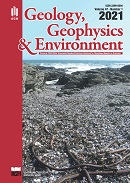Multiscale evaluation of a thin-bed reservoir
DOI:
https://doi.org/10.7494/geol.2021.47.1.5Keywords:
thin bed, high resolution well logs prediction, horizontal resistivity, unsupervised neural network, self-organizing maps (SOM), electrofacies, low resistivity payAbstract
A thin-bed laminated shaly-sand reservoir of the Miocene formation was evaluated using two methods: high resolution microresistivity data from the XRMI tool and conventional well logs. Based on high resolution data, the Earth model of the reservoir was defined in a way that allowed the analyzed interval to be subdivided into thin layers of sandstones, mudstones, and claystones. Theoretical logs of gamma ray, bulk density, horizontal and vertical resistivity were calculated based on the forward modeling method to describe the petrophysical properties of individual beds and calculate the clay volume, porosity, and water saturation. The relationships amongst the contents of minerals were established based on the XRD data from the neighboring wells; hence, the high-resolution lithological model was evaluated. Predicted curves and estimated volumes of minerals were used as an input in multimineral solver and based on the assumed petrophysical model the input data were recalculated, reconstructed and compared with the predicted curves. The volumes of minerals and input curves were adjusted during several runs to minimalize the error between predicted and recalculated variables. Another approach was based on electrofacies modeling using unsupervised self-organizing maps. As an input, conventional well logs were used. Then, the evaluated facies model was used during forward modeling of the effective porosity, horizontal resistivity and water saturation. The obtained results were compared and, finally, the effective thickness of the reservoir was established based on the results from the two methods.
Downloads
References
Allen D.F., 1984. Laminated Sand Analysis. [in:] SPWLA 25th Annual Logging Symposium New Orleans, Louisiana, USA, June 10–13, 1984, SPWLA-1984-XX.
Bała M ., 2011. Evaluation of electric parameters of anisotropicsandy-shaly Miocene formations on the basis ofresistivity logs. Acta Geophysica, 59, 5, 954–966. https://doi.org/10.2478/s11600-011-0033-1.
Borys Z., 1996. Aktualne problemy poszukiwań węglowodorów we wschodniej części przedgórza Karpat. Przegląd Geologiczny, 44, 10, 1019–1023.
Boyd A., Darling H., Tabanou J., Davis B., Lyon B., Flaum Ch., Klein J., Sneider R.M., Sibbit A. & Singer J., 1995. The lowdown on low-resistivity pay. Schlumberger Oilfield Review, 7, 3, 4–18.
Chapman S., Colson J., Everett B., Flaum Ch., Herron M., Hertzog R., La Vigne J., Pirie G., Quirein J., Schweitzer J., Scott H. & Wendlandt R., 1987. The Emergence of Geochemical Well Logging. Technical Review, 35, 2, 27–35.
Jarzyna J., Bała M. & Cichy A., 2009. Elastic Parameters of Rocks from Well Logging in Near Surface Sediments. Acta Geophysica, 58, 1, 34–48. https://doi.org/10.2478/s11600-009-0036-3.
Klein J.D., 1993. Induction log anisotropy corrections. The Log Analyst, 34, 2, 18–27.
Kohonen T., 2001. Self-Organizing Maps. Springer Series in Information Sciences, 30, Springer, Berlin 2001. https://doi.org/10.1007/978-3-642-56927-2.
Krzywiec P., Wysocka A., Oszczypko N., Mastalerz K., Papiernik B., Wróbel G., Oszczypko-Clowes M., Aleksandrowski P., Madej K. & Kijewska S., 2008. Ewolucja utworów mioceńskich zapadliska przedkarpackiego w rejonie Rzeszowa (obszar zdjęcia sejsmicznego 3D Sokołów-Smolarzyny). Przegląd Geologiczny, 56, 3, 232–244.
Mollison R.A., Fannini O.N., Kriegshauser B.F., Yu L., Ugueto G. & van Popta J., 2001. Impact of multicomponent induction technology on a deep water turbidite sand hydrocarbon saturation evaluation. [in:] SPWLA 42nd Annual Logging Symposium, Houston, Texas, June 2001, SPWLA‑2001-T.
Myśliwiec M., 2004. Exploration for gas accumulations in the Miocene deposits of the Carpathian Foredeep using direct hydrocarbon indicators – verification of anomalies (southern Poland). Przegląd Geologiczny, 52, 4, 307–314.
Nooh A.Z. & Moustafa E.A.A., 2017. Comparison of Quantitative Analysis of Image Logs for Clay Volume and Net to Gross Calculation of a Thinly Laminated Reservoir between VNG-NERGE and LAGIA-EGYPT. Egyptian Journal of Petroleum, 26, 3, 619–625. https://doi.org/10.1016/j.ejpe.2016.09.001.
Ramamoorthy R., Flaum C. & Coll C., 1995. Geologically Consistent Resolution Enhancement of Standard Petrophysical Analysis Using Image Log Data. [in:] 70th SPE Annual Technical Conference and Exhibition, Dallas, Texas, USA, October 22–25, SPE 30607.
Ruhovets N., Rau R., Samuel M., Smith H. Jr. & Smith M., 1992. Evaluating thinly laminated reservoirs using logs with different vertical resolution. [in:] Hurst A., Griffiths C.M., Lovell M.A., Morton A.C., Worthington P.F. (eds.), Geological Applications of Wireline Logs II, Geological Society Special Publications, 65, Geological Society of London, 99–121. https://doi.org/10.1144/GSL. SP.1992.065.01.08.
Serra O., 1984. Fundamentals of Well-Log Interpretation. Developments in Sedimentology, 15, Elsevier. Serra O. & Andreani M., 1991. Thin Beds: A Guide to Interpretation of Thinly Layered Reservoirs. Schlumberger.
Shahinpour A., 2013. Borehole image log analysis for sedimentary environment and clay volume interpretation. Norwegian University of Science and Technology, Department of Petroleum Engineering and Applied Geophysics. https://core.ac.uk/download/pdf/52100408.pdf [access: 1.02.2021].
Zawisza L. & Nowak J., 2012. Metodyka określania parametrów filtracyjnych skał na podstawie kompleksowej analizy danych geofizyki otworowej. Wydawnictwa AGH, Kraków.
Downloads
Published
Issue
Section
License
Authors have full copyright and property rights to their work. Their copyrights to store the work, duplicate it in printing (as well as in the form of a digital CD recording), to make it available in the digital form, on the Internet and putting into circulation multiplied copies of the work worldwide are unlimited.
The content of the journal is freely available according to the Creative Commons License Attribution 4.0 International (CC BY 4.0)










